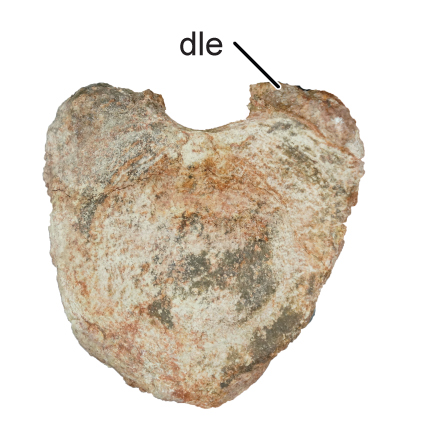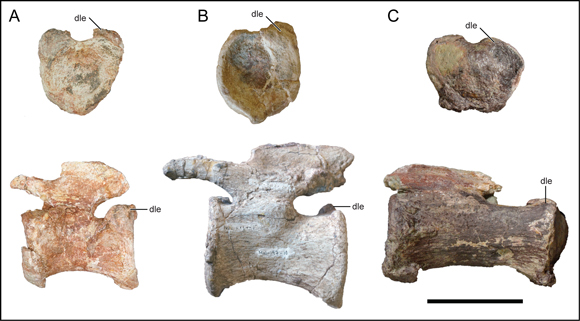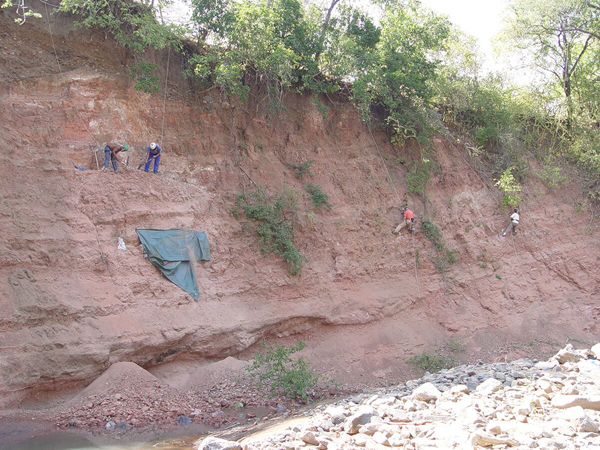Mnyamawamtuka moyowamkia – Heart-shaped Tail Bones Help to Flesh Out Titanosaur Evolution
Scientists writing in the on-line, open access journal PLOS One, have published details of a new species of African titanosaur. It took several years to carefully remove the fossil material from a high cliff wall overlooking the Mtuka riverbed in south-western Tanzania, but the fossils, representing a not fully mature dinosaur, are providing palaeontologists with important information about how African ecosystems changed over the course of the Cretaceous. The new titanosaur has been named Mnyamawamtuka moyowamkia (pronounced Mm-nya-ma-wah-mm-too-ka mm-oh-yo-wa-mm-key-ah). The name is derived from Kiswahili for “animal of the Mtuka river with a heart-shaped tail”.
The heart-shaped tail element of the name refers to the strange shape of the most intact middle caudal vertebra described in the paper. It bulges out at the sides (dorsolateral expansion of the posterior articular surface of the centrum), a unique tail bone morphology that resembles the shape of a romantic, love heart.
A Life Reconstruction of a Pair of Mnyamawamtuka moyowamkia Titanosaurs
Picture credit: Mark Witton
Mnyamawamtuka moyowamkia
The first evidence of the dinosaur fossils was noted in 2004 and some fossils were excavated from the cliff face, in what were quite hazardous conditions, with field team members having to be lowered over the cliff on numerous occasions to work on the exposed bones. Annual excavations took place until 2008, it was important to keep returning to the site as the fossils were in danger of being lost to the river in seasonal floods.
A Line Drawing of the Quarry Site Showing the Extent of the Annual Excavations
Picture credit: PLOS One
Around 110 -100 Million Years Old
The specimen was excavated from the Mtuka Member of the Cretaceous Galula Formation, which was deposited around 110 to 100 million years ago (Aptian to Cenomanian faunal stage of the Cretaceous). A substantial portion of the postcranial skeleton has been recovered.
Dangerous Work! The Excavation Site in 2007
Picture credit: Ohio University
Commenting on the importance of this discovery, in relation to the evolution of African titanosaurs, lead author of the paper, Dr Eric Gorscak, a recent PhD graduate of Ohio University and now an assistant professor at the Midwestern University (Illinois), stated:
“Although titanosaurs became one of the most successful dinosaur groups before the infamous mass extinction capping the Age of Dinosaurs, their early evolutionary history remains obscure, and Mnyamawamtuka helps tell those beginnings, especially for their African-side of the story. The wealth of information from the skeleton indicates it was distantly related to other known African titanosaurs, except for some interesting similarities with another dinosaur, Malawisaurus, from just across the Tanzania–Malawi border.”
Adding to the Diversity of Titanosaurian Sauropods from Africa
The field team responsible for this discovery have also found the fossilised remains of two other titanosaurs in this part of Africa. In 2017, Everything Dinosaur reported upon the discovery of Shingopana songwensis.
To read about S. songwensis: A New Species of African Titanosaur is Named.
In addition, Rukwatitan bisepultus another Titanosaurian sauropod dinosaur, was named and described in 2014: A New Species of Titanosaurian Sauropod Rukwatitan bisepultus.
The researchers conclude that Mnyamawamtuka moyowamkia was distantly related to both Shingopana songwensis and Rukwatitan bisepultus, fossils of which come from younger Cretaceous sediments, although it did share some anatomical characteristics with Malawisaurus dixeyi from Malawi, that might have been contemporaneous. This new fossil discovery is helping palaeontologists to better understand the distribution of titanosaurs between Africa and South America and their evolutionary relationships.
Heart-shaped Tail Bones
One of the middle caudal centra (tail bone from the middle portion of the tail), exhibits a unique dorsolateral expansion of the posterior articular surface of the centrum. This unique characteristic was found to be present in the most intact middle caudal vertebra described. This unique shape inspired the dinosaur’s name.
Heart-shaped Tail Bone Centrum (Rear View)

Picture credit: PLOS One
Tail Bones of Different Titanosaurs Compared

Picture credit: PLOS One
The scientific paper: “A New African Titanosaurian Sauropod Dinosaur from the Middle Cretaceous Galula Formation (Mtuka Member), Rukwa Rift Basin, Southwestern Tanzania” by Eric Gorscak and Patrick M. O’Connor published in PLOS One.
Visit the Everything Dinosaur website: Everything Dinosaur.









Leave A Comment